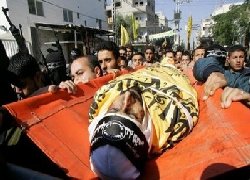The Palestinian Authority (PA) has shown operational willingness to cooperate with Israel to kill its own people, the Palestine Papers indicate.
Among the documents are notes, handwritten in Arabic, revealing an exchange in 2005 between the PA and Israel on a plan to kill a Palestinian fighter named Hassan al-Madhoun, who lived in the Gaza strip.
Al-Madhoun (born 1973) was a leading figure within the Al Aqsa Martyr’s Brigade, a movement aligned to Fatah, which at that stage still held power in Gaza. Al-Madhoun had been accused by Israel of planning deadly bombings at Israel’s Ashdod port and the Qarni crossing between Gaza and Israel.
In a joint committee meeting on fugitives in mid-2005 in Tel Aviv between Shaul Mofaz, the then-Israeli defense minister, and Nasser Youssef, the PA minister of interior, the PA was asked to kill al-Madhoun.
Mofaz: “[…] Hassan Madhoun, we know his address and Rasheed Abu Shabak [chief of the Preventative Security Organization in Gaza] knows that. Why don't you kill him? Hamas fired [Qassam rockets] because of the elections and this is a challenge to you and a warning to Abu Mazen [Mahmoud Abbas, the PA president].”
Youssef: “We gave instructions to Rasheed [Abu Shabak] and will see.”
Mofaz: “Since we spoke, he has been planning an operation, and that's four weeks ago, and we know that he wants to strike Qarni or Erez [another border crossing between Gaza and Israel]. He is not Hamas and you can kill him.”
Youssef: “We work, the country is not easy, our capabilities are limited, and you haven't offered anything.”
Mofaz: “I understand that nothing has been accomplished in the [Gaza] Strip.”
Less then a month after this meeting, on November 1, 2005, al-Madhoun was killed in his car by a missile fired from an Israeli Apache helicopter over the skies of Gaza. The attack also killed a wanted Hamas activist and wounded three other people.
The very next day, Mofaz, who by that time was in Washington, pledged to ease the lives of Palestinians and to pursue peacemaking with President Abbas.
"We want to deal with President Abbas," Mofaz said after meeting with Condoleezza Rice, the then-US Secretary of State, before going to the White House to confer with Stephen Hadley, the then-national security adviser.
"We are waiting to see how the Palestinian Authority will deal with terrorist groups," the Israeli minister said.
The Palestine Papers appear to reveal two primary motives for the Palestinian Authority’s collaboration with Israel and their crackdown on dissent.
Firstly, it serves to maintain the movement’s political supremacy at a time when it is being questioned. Secondly, it is an attempt to signal to the US that it wants to remain a trusted partner in 'peace' talks, regardless the costs.
Saeb Erekat, the PA’s chief negotiator acknowledged the cost of gaining US approval and Israeli trust, in a meeting on September 17, 2009 with David Hale, the deputy US Middle East envoy.
Erekat: We have had to kill Palestinians to establish one authority, one gun and the rule of law. We continue to perform our obligations. We have invested time and effort and killed our own people to maintain order and the rule of law.
It is not clear as to which killings Erekat is referring to but the discussion about the plan to kill al-Madhoun is just one example of how, since the death of Yasser Arafat, Fatah’s policy of resistance to Israel has become one of collaboration.
The Palestine Papers show how the Al Aqsa Martyr’s Brigade, once the spearhead of action against the Israeli occupation, has been transformed into a body that helps maintaining it.
During the Annapolis talks in 2008, Ahmed Qurei, the former Palestinian prime minister also known as Abu Ala, and his Israeli counterpart Tzipi Livni, discussed collaboration between the brigade and the Israeli security forces.
“Al Aqsa Martyr’s Brigade is part of the Fatah movement and they agreed to be part of the current security apparatus, even though this was not my position when I was a prime minister. I wanted the Brigade to remain as it was to confront Hamas,” Qurei told Livni.
With the common goal of destroying Hamas, the Palestine Papers reveal the extent to which the PA, the US and Israel were willing to work together, and the extent to which the PA linked the fate of Hamas with its own political survival.
“[…] reaching an agreement is a matter of survival for us. It’s the way to defeat Hamas,” Erekat told Marc Otte, the EU negotiator, in June 2008.
Earlier that year, on January 22, Qurei told Livni; “We’ll defeat Hamas if we reach an agreement, and this will be our response to their claim that gaining back our land can be achieved through resistance only.”
PHOTO CAPTION
Palestinian mourners carry the body of Hassan al-Madhoun, leader of the al-Aqsa Martyrs Brigades, during his funeral in Jabalia refugee camp, northern Gaza Strip in 2005.
Source: Aljazeera.net


 Home
Home Discover Islam
Discover Islam Quran Recitations
Quran Recitations Lectures
Lectures
 Fatwa
Fatwa Articles
Articles Fiqh
Fiqh E-Books
E-Books Boys & Girls
Boys & Girls  Articles
Articles










